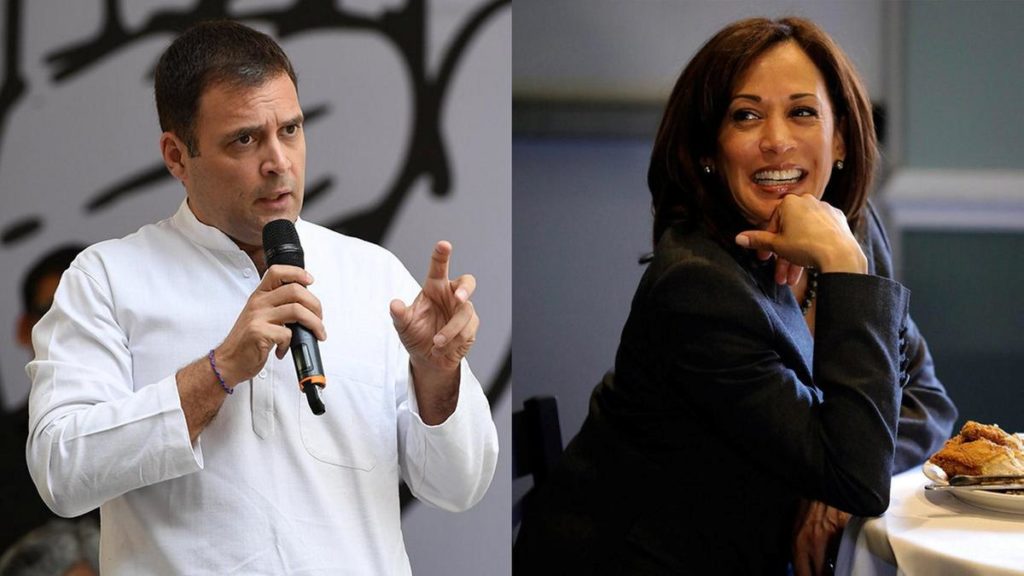Kamala Harris and Rahul Gandhi are taking politics back to basics

Rahul Gandhi and Kamala Harris are seeking to end poverty for millions with new policies.
Although separated by thousands of miles, both politicians are trying to find workable solutions to economic problems affecting millions of people
Two politicians in two different parts of the world are trying to turn forthcoming elections in their respective countries by persuading voters that they care. And they’re doing it by promising to put money directly in the pockets of ordinary people. Are their plans shrewd attempts to win votes, or serious attempts to reduce social inequality?
In India, the world’s largest democracy, Rahul Gandhi has promised a minimum-income scheme for the poorest 20 per cent of households. It is an enormously ambitious plan for India, a nation of more than 1.3 billion people that is struggling to break out of its status, defined by the World Bank, as a “lower-middle-income country”.
In the United States, sometimes referred to as the oldest democracy, Kamala Harris is promising an average $13,500 pay raise for every teacher. This is an extraordinary attempt to end in-work poverty for a highly educated group in the richest country in the world.
What links Mr Gandhi and Ms Harris is the point at which their policies intersect. They are, in their grand design, attempts to find solutions for social injustice.
Mr Gandhi, leader of Congress, India’s main opposition party, has said that if he wins upcoming elections, 50 million of the country’s poorest families would be guaranteed payments of 72,000 rupees (Dh3,840) a year. The scheme would be called Nyay, meaning “justice”. Mr Gandhi describes it as India’s “final assault on poverty”.
And Ms Harris, who is running to be the Democratic Party’s 2020 presidential nominee in a crowded political field, sees the issue of teachers’ pay as crucial to America’s future. Teachers in the US are more likely than other professionals to work a second job. One million — roughly 40 per cent — are reportedly not covered by Social Security. Those working in public schools earn 11 per cent less than similarly qualified professionals in other fields. In 30 of America’s 50 states, average teacher pay is less than the living wage for a family of four.
These are the many reasons why teacher protests for higher pay and better benefits continue to break out across the country. Ms Harris’s campaign describes the plan as “the largest investment in teachers in American history”. Discount the hyperbole, and it is still one of the most ambitious proposals by a US presidential candidate to invest in education and in the next generation.
The proposals advanced by Ms Harris and Mr Gandhi should not be dismissed as cynical “competitive populism”.
That phrase has been used by Indian commentators in reference to the Congress leader’s plan, mostly because Prime Minister Narendra Modi recently pledged 6,000 rupees (Dh320) a year to small and marginal farmers, holding cultivable land of up to two hectares. As for Ms Harris, it would not be unusual if she was seeking to use teacher pay as a wedge issue between her campaign and that of the dozen or so other Democrats running for the party’s nomination.
But isn’t politics meant to be about such bread-and-butter issues? Isn’t it entirely right and proper for politicians to try to force the national conversation towards an overarching narrative of social compassion?
Yogendra Yadav, an Indian academic and co-founder of the socio-political organisation Swaraj Abhiyan, recently said that Mr Gandhi’s plan is to be welcomed for taking the election “back to basics”. Rather than highly charged security issues and muscular nationalism, he said, “we are debating, discussing, as we should, something real, substantive, that really affects the lives of [millions] of people in this country”. The minimum income scheme “at least begins to acknowledge that the poor need a stimulus,” he added.
The same, albeit in a slightly different context, could be said of Ms Harris’s proposal for America’s teachers.
In his new book, The Third Pillar: How Markets and the State Leave the Community Behind, the economist Raghuram Rajan, of the University of Chicago, addresses the need for social protections or, at the very least, opportunity for all. He compares the West and India in terms of the rising sense of economic hopelessness.
In the US, for instance, growing income segregation and market demands “are creating a meritocracy, but a hereditary one”. In India, Mr Rajan says, there has not been enough investment in providing jobs for people of “moderate education” and in creating opportunity for the poorest of the poor.
These factors have affected the politics of both countries. After Donald Trump’s election, the Harvard political philosopher Michael Sandel explained the rise of populism in terms of the ceaseless human search for justice.
The economic policies of Ronald Reagan and Margaret Thatcher were based on the belief that the market could fix everything. After them, a new clutch of centre-left leaders took charge. But Bill Clinton, Tony Blair and Gerhard Schroeder didn’t tinker much with the system. Crucially, they did nothing to make it fairer. This meant, in Mr Sandel’s words, that market economies became “market societies”, soulless and valueless constructs that discourage the expectation of justice.
Mr Gandhi and Ms Harris’s sweeping proposals go some way towards plugging that gap.

